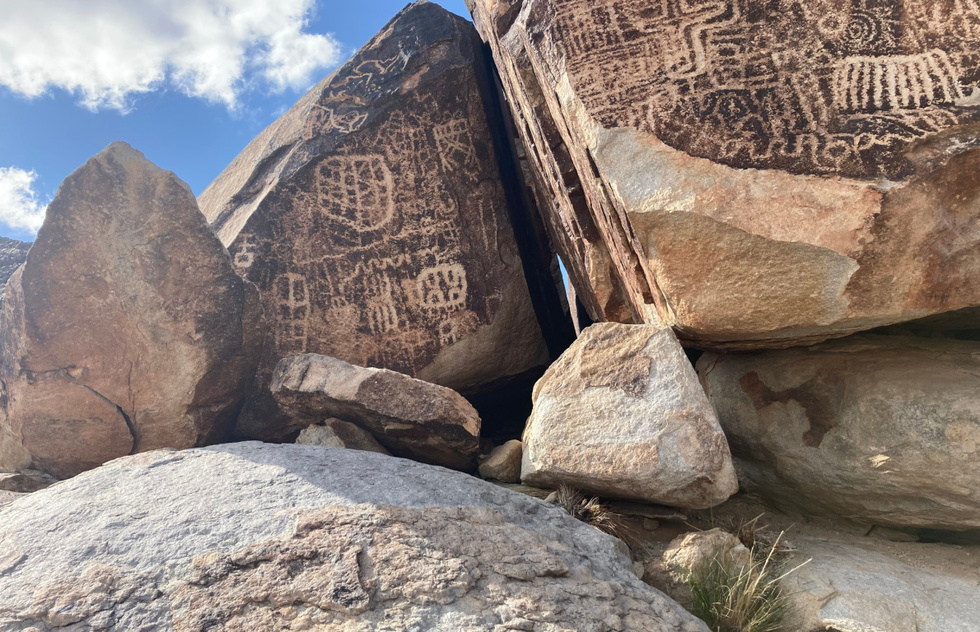President Joe Biden has designated two more national monuments that are precious to the history, culture, and natural resources of the United States.
Combined, the newly protected areas account for 514,000 acres of public lands.
The first area to be classified as a new national monument is Avi Kwa Ame National Monument, which spans 506,814 acres in the southern tip of Nevada.
The name choice is significant. Western settlers called the land Spirit Mountain, but the federal government has chosen to designate the preserve by an Indigenous name.
"Avi Kwa Ame is considered to be among the most sacred places on Earth by the Mojave, Chemehuevi, and some Southern Paiute people," the White House said in a statement. "It is also important to other Tribal Nations and Indigenous Peoples including the Cocopah, Halchidhoma, Havasupai, Hopi, Hualapai, Kumeyaay, Maricopa, Pai Pai, Quechan, Yavapai, and Zuni Tribes."
Avi Kwa Ame contains the so-called Grapevine Canyon Petroglyphs (pictured above), which were painted some 1100 to 1900 years ago and are listed on the National Register of Historic Places.
The region is also home to one of the planet's largest Joshua tree forests and serves as a habitat or migration corridor for species such as the bighorn sheep, desert tortoise, and Gila monster, the White House said.
Native groups celebrated the announcement.
"This is truly a historic day as it signifies a change in posture towards Indigenous people from the federal government than that which we are unfortunately used to by now,” Taylor Patterson, the executive director of Native Voters Alliance Nevada, told the New York Times.
According to the Times, the area is only the second national monument to be created for the protection of Indigenous history. It's also the largest monument that President Biden has designated so far.
About 33,000 acres of the mountain were previously protected. The expanded land will create a corridor that connects the Mojave National Preserve and the Castle Mountains National Monument in California to the Sloan Canyon National Conservation Area and Lake Mead National Recreation Area in Arizona and Nevada.
Nevada Gov. Joe Lombardo, a Republican, complained that the designation could disrupt industrial mining rights.

(Photo: Castner Range National Monument. Credit: Shutterstock / BrianWancho)
The other area Biden chose to preserve as a national monument under the Antiquities Act is the 6,672-acre Castner Range National Monument, a high-desert mountain district that in the 20th century was used as a firing and testing range for the Fort Bliss Army post near El Paso, Texas.
The land's capacity as a weapons training ground ended in 1966, but so far it has not been safe to reopen the site to vacationers. That will change, but first the land must be scoured for unexploded ordnance, the New York Times reports.
"Protecting Castner Range connects the area with the Franklin Mountains State Park, creating continuous habitat for wildlife and improved public access for outdoor recreation," the White House statement said. "Castner Range also hosts significant cultural sites documenting the history of Tribal Nations, including the Apache and Pueblo peoples and the Comanche Nation, Hopi Tribe, and Kiowa Indian Tribe of Oklahoma."
Also this week, Biden directed the National Oceanic and Atmospheric Administration to designate all the waters surrounding the Pacific Remote Islands, which lie to the south and west of Hawaii, as part of a national marine sanctuary.
Smaller, incomplete sections of the marine territory, which includes Wake Atoll, Johnston Atoll, Kingman Reef, and Howland and Baker Islands, were first protected in 2009 in the final days of the second Bush administration.
"If completed, the new sanctuary would ensure the U.S. will reach the President’s goal of conserving at least 30% of ocean waters under American jurisdiction by 2030," the White House said in a statement about the proposed expansion.
"The Pacific Remote Islands including their waters are not only a critical interlocking component of the broader Pacific marine ecosystem, but [also] an integral part of the historical and cultural ties of the indigenous peoples of the Pacific as well as a key source of scientific knowledge on the preservation of a sustainable ocean environment," said Congressman Ed Case (D-HI) in a statement cheering the move.
The Pacific Remote Islands Coalition, an advocacy group comprising fisherman, scientists, community elders, religious groups, and others, had been lobbying for the protection over multiple White House administrations.
"The Pacific Remote Islands are home to some of the last wild and healthy ocean ecosystems on our planet," the coalition's website points out. "The land and sea hold rich history, from ancient Polynesian voyaging, to the efforts of the Hui Panala'au, to the Pacific theater of WWII."
Last fall, President Biden designated the Camp Hale–Continental Divide National Monument, which has its own natural and military significance, out of 54,000 acres of Colorado wilderness.
You May Also Like:
• 10 Places for Native American Vacation Experiences with Your Family
• New Online Hub for Finding Native American Experiences in California






